What do you like to do on a Friday evening when you sit on the couch?
Are you eating a good dinner?
Are you sipping your favorite drink?
How else do you spend your free time?
I’m going to guess that you reach for the remote control and start looking for an interesting program on a streaming platform.
You happily choose a great movie.
You press the “play” button and are disappointed because the quality of the video is very poor, even though it should be 4K!?
Do you have the same problem?
Stefan was like this for many days, until he sat down at the computer instead of watching a movie.
Stefan made two decisions.
First, he wrote an e-mail terminating the contract to the current mobile Internet provider.
Secondly, he looked for a competitive solution.
In two weeks, the installer came and connected him to the Internet via optical fiber.
This is how Stefan ended his “sufferings” himself.
Can anyone be like Stefan and change service providers?
Not everyone has a chance to connect optical fiber.
How operator can help its customer in this case?
What should a mobile operator do in such a situation, which is often the only option for the recipient?
And why does the Internet from your mobile operator jam during peak hours anyway?
One of the reasons may be a problem with the network, which is heavily loaded during peak hours.
How do operators deal with an overloaded mobile network?
Problems with the load on mobile networks have been a big problem for many years.
Several methods can be used, together or separately:
- Build more base stations
- Add additional transmitters on a different cellular band
- Install devices in the network that improve the quality of IP connections (IP optimization)
- Launch systems that adapt streaming quality to link quality (ABR).
Each of these solutions has its advantages and disadvantages.
I describe them later in the article.
One of the biggest obstacles, however, is that all of these methods are expensive and cumbersome.
The duration of their implementation, costs, involvement of project teams, and administrative difficulties increase the demand for resources that exceed the possibilities of network development.
The operator simply cannot keep up with the need to provide network capacity for the above reasons.
Fortunately, new technology is coming that will help solve much of this problem in 5G networks.
I am talking about 5G MBS (Multicast Broadcast Services) technology.
5G MBS is a technology that increases the efficiency of mobile networks
5G MBS is one of the latest solutions defined in 3GPP standards version 17.
I will add that in standards already accepted and in force since 2023.
The main benefit is the use of communication techniques with multiple terminals at the same time.
Unicast, Broadcast, and Multicast, differences in technology operation
I like to explain such differences best with pictures.
The graphic below shows the differences between the three basic communication techniques.
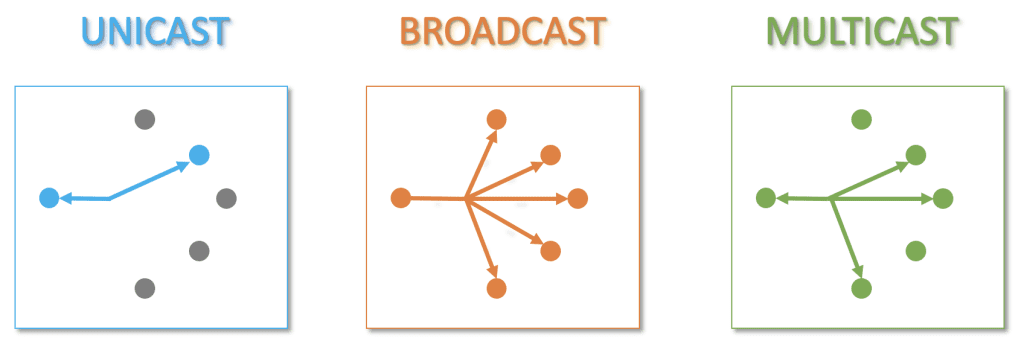
Unicast is the One-on-one bi-directional communication.
Broadcast is the One-to-many one-direction communication.
Multicast is the One-to-many bi-directional communication.
The basis of operation of mobile networks
Interesting thing.
Most people simply do not know which communication technique cellular networks use.
Do you know?
Mobile networks operate mainly based on Unicast technology.
I am writing mainly because for years there have been attempts to implement broadcast solutions into the standard.
So far, to no avail.

An interesting thing is that multicast techniques have been used in IP networks for years (IP multicast).
To a large extent, this technique has been transferred to the framework of mobile networks in 5G MBS technology.
The graphics make you aware of the basic differences between the techniques:

Benefits of using 5G MBS technology for customers and mobile networks
I’ll start with the advantages.
Basic advantages of 5G MBS:
- The principle of operation of Multicast is similar to Broadcast in terms of efficiency but allows for personalization of content and interaction with recipients.
- MBS is more efficient than unicast for large numbers of recipients.
- Modern content distribution technology combines the advantages of broadcast and Unicast, offering high efficiency, content personalization, and interaction with recipients.
- Ability to switch context IP between all techniques.
The creators of the standard came up with a great approach.
There is no need to choose whether the network should be configured as Unicast, Broadcast, or Multicast.
Mechanisms have been used that will allow you to change the type of connection in the radio network with accuracy down to a single cell.
This can be done by the radio access network itself, but it can also be requested by an application on the AS application server or at the UE terminal.
Some of these options will be available from the 3GPP standard version 18, effective from March 2024.
A change in the method of communication may result from the needs of the application that will use this technology.
Areas of commercial application of 5G MBS technology
Is 5G MBS just for streaming services?
Of course not.
There are several ideas for specific products, already prepared within the standards:
- Public safety. Multimedia alerts with instructions, tips, and information. For example, information about threats such as fire, flood, chemical accident, etc.
- IPTV, television or radio broadcast. Television and radio transmission, video on demand, etc. Currently, some of the most desired sources of data streams are used by customers. Examples include Netflix, YouTube, HBOMax, etc.
- MCPTT group communication. Mission Critical Pushing To Talk (MCPTT). Support critical group communications technology. Communication for services such as fire brigade, city guard, and police.
- Software delivery via OTA (Over-The-Air). IoT solutions (Internet-of-Things). Software update, patching software holes, managing IoT device configuration. In addition to communication with IoT devices, we can also talk about mass software upgrades, e.g. the Windows operating system. It is also a difficult service for the operator and puts a heavy load on the network.
- Multicasting or transmission in public places such as stadiums – HOTSPOT. Watching football events in the stadium with support for Zoom, multi-angles, repeat functions, etc. Additional video services are offered in a small but highly populated place.
- Broadcast and Multicast transmission to vehicles (V2X). Road safety services in the V2X (Vehicle-to-Everything) standard: Forward Crash Warning (FCW), Optimal Speed Advisory (OPA), etc.
These are examples of how the technology can be used for specific applications.
In which service segments can this solution be used?
Service segments using 5G MBS technology
I have prepared a simple table showing the connection between the technology area and service segments.
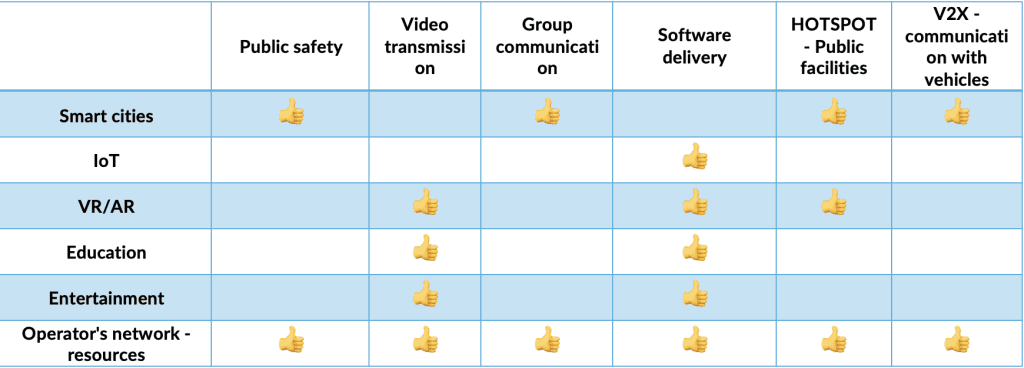
Smart cities
Due to the large concentration of inhabitants, residential buildings, public utilities, and vehicles, the city is a place that is crying out for this technology.
Public safety in the area of a dangerous event and the need for quick communication with its inhabitants. Examples of alerts about weather changes, information about accidents, and urban threats.
MCPTT group communication systems for municipal services. Fire, police, ambulance. Is such a solution necessary if the services use TETRA systems?
Of course. The basis for the services’ operation is to maintain alternative communication systems. The failure of one allows the services to remain in constant contact.
All group events such as matches, concerts, or picnics require better communication, increased network capacity, supervision of a large quantity of cars, etc.
HOTSPOT solutions are perfect for a smart city.
Finally, intelligent communication systems between vehicles, pedestrians, and cyclists.
The technology for such mutual communication is called V2X (Vehicle to Everything). V2X allows you to predict certain road events and inform each other about objects on the road.
These four types of applications show how important the use of 5G MBS technology may become shortly.
IoT
Delivering new software, fixing software bugs or mass collection of information from IoT devices can be improved thanks to the 5G MBS technique.
If we consider more complex IoT devices using video terminals, this area can be expanded to include video transmission.
VR/AR
The mass development of these services is still quite far away.
In fact, the situation may change after the spread of Apple VisionPro devices, which are already revolutionizing the market.
The popularity of VisionPro glasses will increase once more services are offered for them, such as the Omniverse platform from Nvidia.
It’s already happening.
Either way, mass delivery of video services or software will be allies of this segment.
Education and Entertainment
As in the case of the previous segment, providing video services and providing software will be helpful for this segment.
Remote lessons, online training, virtual participation in seminars or conferences.
During the key note speech of the Nvidia president at the GTC Nvidia 2024 conference, approximately 500,000 virtual observers from around the world were connected.
The potential is huge.
Operator’s network – resources
The mobile operator, as a company providing services to all the above segments, can gain the most from 5G MBS.
In addition to providing a more effective form of communication, it will allow the operator to save network resources.
The expansion of the access and transmission networks are the most expensive elements of the mobile network.
This concerns the costs of construction (CAPEX) and network maintenance (OPEX).
According to According to calculations by Rohde & Schwarz, the operator can save up to 20% of network expansion costs. This applies to video transmission (streaming), one of the most expensive solutions in mobile networks.
Can every operator use this technology in the network?
5G MBS solution architecture
The 5G MBS solution is based on the 5G SA (5G Stand Alone) network architecture.
This means that the operator will only receive the benefits of this product in the 5G SA network.
Is this a big problem?
Not.
In January 2024, the GSA report identified 308 commercial networks in 118 countries.
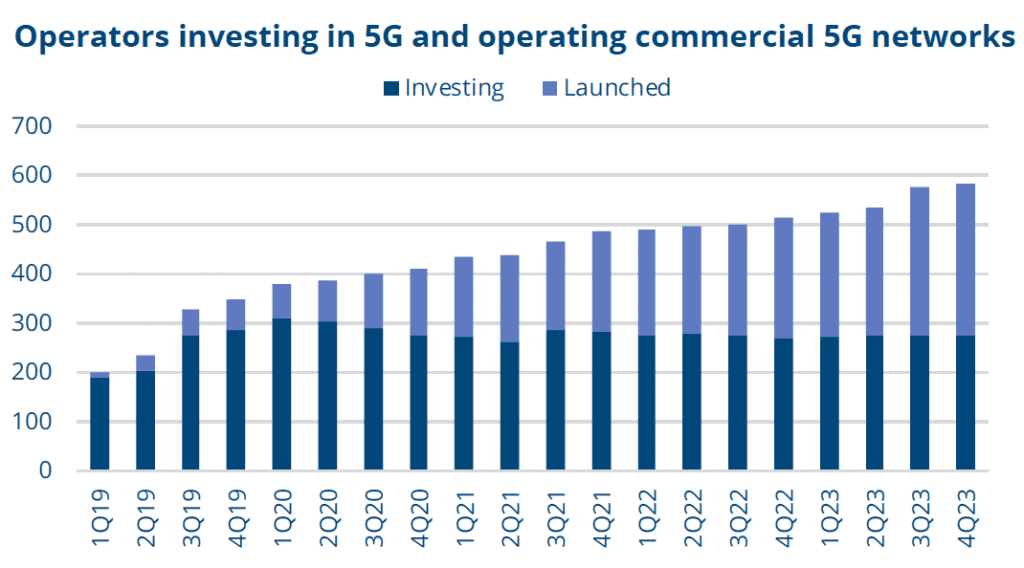
In addition, there are more and more private networks.
As mentioned, the 5G radio network itself is not everything.
This also requires the 5G SA backbone network architecture (SBA).
GSA reports approximately 121 5G SA architecture implementations on all continents as of January 2024.
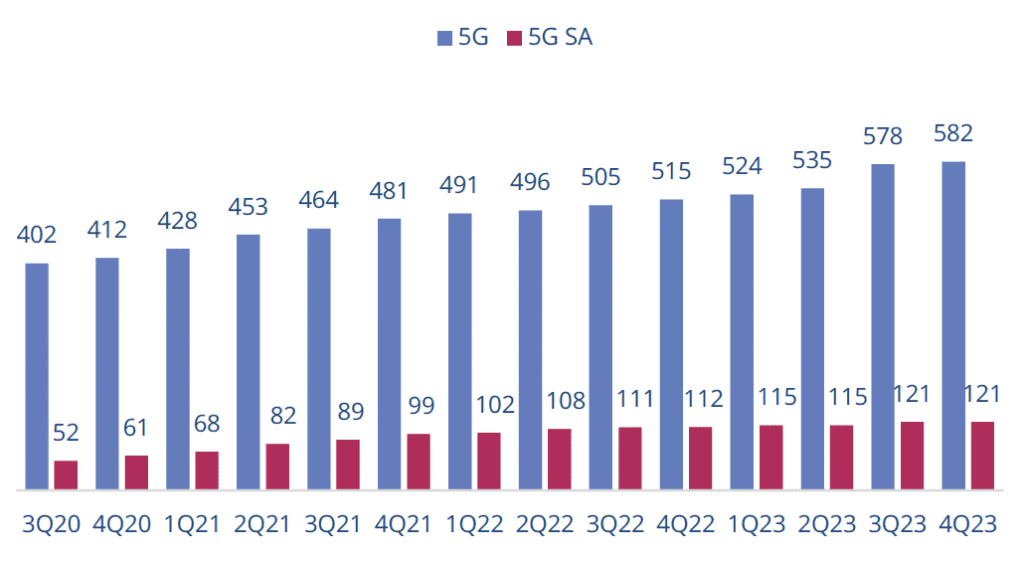
Therefore, statistically, every fourth operator is architecturally ready for implementation.
This is a very good start.
Does the implementation of 5G MBS require major network changes?
Solution architecture.
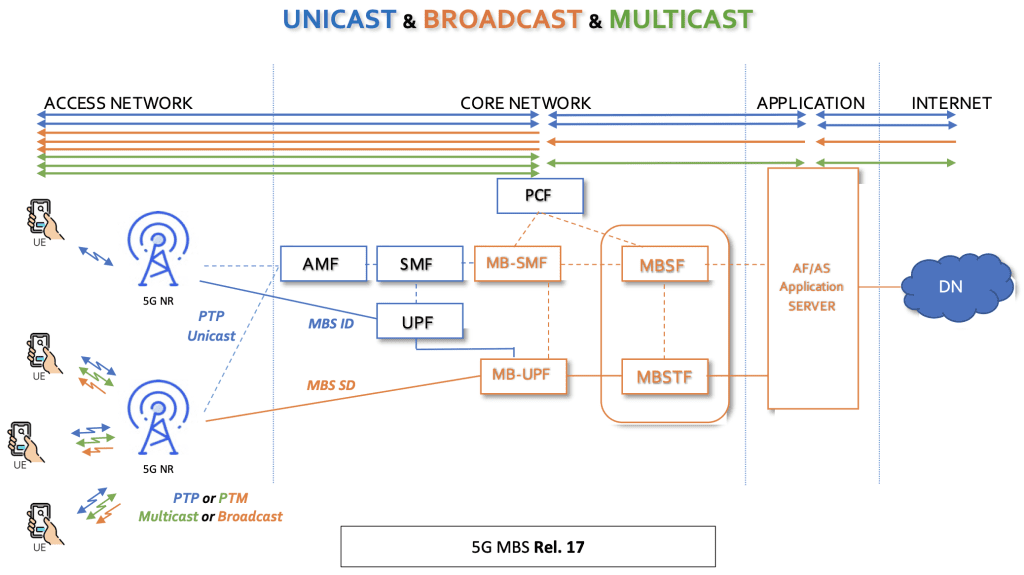
First, the radio network must support this technology. In most cases, this means changing the software on the base stations.
On the Core network side, two new network functions are implemented, dedicated to supporting multicast communication.
These are MB-SMF and MB-UMF.
Thanks to the SBA architecture, in practice, this means changes in the software and its architecture. Plus changes in transmission and network connections.
The existing Core 5G SBA network additionally requires software upgrades.
Relatively little change and cost compared to the expected profit.
The future of 5G MBS under 3GPP standards version 18. New opportunities
The basic version of the 3GPP standard was approved in version 17.
In version 18, a few important changes were additionally proposed.
- Multicast reception support in an INACTIVE state. This change was dictated by the idea of reaching the customer with crisis alerts or television broadcasts without an active radio channel. This is a huge change to the way we communicate with devices on a mass scale.
- Support for AF-triggered on-demand MBS multicast sessions and use of multicast and/or unicast delivery for a specific service. This change is extremely important for the application. For example, the CDN application on the subscriber’s mobile device may decide to change the form of communication, e.g. from Broadcast to Unicast. Lots of scope for application providers. Changing communication from mass to individual and vice versa has huge marketing and income potential.
- Hybrid solution with 5G Media Server (5GMS). A brilliant move by 3GPP to offer the benefits of 5G MBS to broadcasters. The solution allows you to connect the world of mobile networks and the world of television or streaming services. I will write about this in an additional article.
The most interesting thing is that when I write this article, the 18th version of the 3GPP standards is coming into force. March 2024.
An example of the use of 5G MBS technology in a mobile operator’s network
For many years, mobile operators have had a very big problem with network capacity during peak traffic hours.
Practically since the popularization of streaming services, many places on the network have been congested during peak hours.
The thing about mobile networks is that the last mile (access to the subscriber) is a shared technology.
Finite radio resources (radio band, transmitting power of radio devices) in an area are simply limited.
These resources are shared among subscribers.
The greater the number of subscribers in a housing estate, the less network capacity there is for each subscriber.
This means that new subscribers to some extent “take away” the resources and quality of the network from the existing ones.
Methods for reducing network resource congestion on the quality of data connections
The operator has several options to combat the limitation of network quality and radio resources.
- Construction of a new radio station. This is an expensive and often impossible solution. The restrictions result from environmental restrictions (legal regulations) or even the reluctance of residents to new masts or antennas.
- Adding new transmitters to the existing base station. This option is one of the fastest and best techniques from the operator’s point of view. It carries a cost, but in the long run, it allows you to give your customers a break. The limitations are again environmental regulations and consent from building owners.
- Increasing the number of sectors on the base station. As in previous cases, new radio devices are added, on different frequencies. This is a high cost and requires a change in the network architecture of many nearby base stations.
- Optimizing the IP connection in the Core network and the transport network. This technique involves a very complicated change in the way the algorithm for connecting the end device over the IP network works. The operator installs devices dedicated to this solution in its backbone network. This solution costs more and more. Its cost increases with the increase in traffic measured in GB.
Radio teams and teams responsible for construction works are working on solutions 1, 2, and 3.
These changes take place on a point-by-point basis.
Base stations that regularly experience congestion are expanded with one of these techniques.
Solution 4 is installed once and then it is maintained and developed (investment in hardware and software) as network traffic increases.
The increase in costs is relatively linear to the increase in traffic.
This solution applies to traffic from the entire network. From all base stations.
How will 5G MBS technology help with the problem of network congestion?
The topic is rather obvious in my opinion.
The introduction of end devices and applications using the streaming solution based on 5G MBS will help save a huge part of the network.
When more devices will start using Broadcast or Multicast communication, the more radio and transmission resources the operator will save.
Implementing 5GMBS will help solve the problem point-wise and/or globally.
5GMBs can be configured with an accuracy of one radio cell.
That is, a single base station may or may not use this 5G technology.
The more stations are switched on in this mode, the more the operator will save on the total transmission in the middle of the network.
There is one more gain for the operator.
Fewer sessions and less data traffic will be collected from third-party streaming providers.
In some cases, the operator pays extra for higher traffic.
5G MBS and smart cities. Development thanks to 5G MBS technology.
Are savings for the operator the only profit?
Of course not.
The applications and applications mentioned at the beginning of the article may be based on multicasting and this is a potential for new applications.
Cities should be the second most interested in this technology after the operator.
The application potential is wide.
A potential that could impact how 5G private networks are implemented.
5G MBS challenges on user terminals (smartphone, tablet, CPE)
For a mobile operator, no technology exists and makes no business sense until the mass use of terminals with their support.
Due to the lack of support for broadcast solutions in terminals in the past, no version of it was successful.
A survey of operators, at the time of attempts to deploy Broadcast on LTE, shows this clearly.
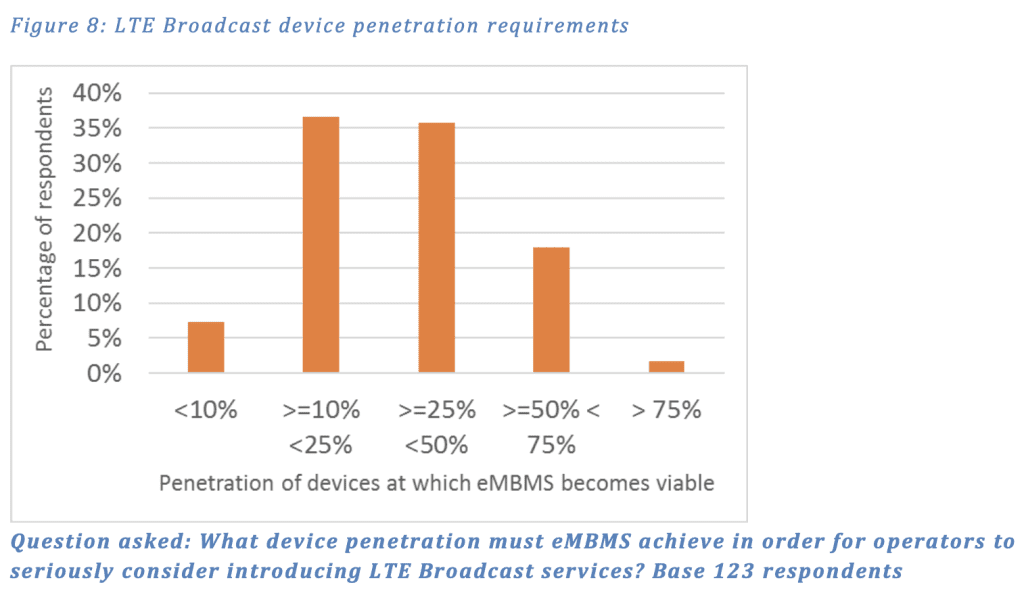
Could a similar fate befall 5G MBS?
I have not been able to receive information from terminal suppliers on whether they intend to support this solution.
Theoretically, existing 5G terminals should be able to cope with version 17.
All that would be required was to upgrade the software in the terminal.
Is the implementation of 5G MBS a matter of the near future?
I strongly believe that this time it will be successful.
And measurably quickly.
To sum up, 5G MBS technology brings benefits to all market players.
- Operators – network capacity, implementation of new services that will bring profits.
- Content providers – new opportunities to offer advertising services and direct traffic to individual clients.
- Application providers – video traffic optimally delivered to the user? Nothing could be simpler with the new 5G MBS technology.
- Cities – A smart city can benefit in several ways.
- End users – everything above is a profit for the customer. In many ways.
5G technology brings many new features resulting from the flexibility of the architecture and the universality of the solutions.
Do you want to discuss with me that technology?
Very interesting article! I’m wondering about the implementation of the new MB-SMF and MB-UPF functions. Probably vendors will provide them in packages as single CNFs (SMF+MB-SMF) and (UPF+MB-UPF). But the question is indeed whether it will be beneficial for operators to invest in additional features that may be limited by the terminals themselves. Who will take the first step?
Excellent view. The survey presented on the bottom of the article somehow answer to that question. If the number of terminals available will grow that the operators will more invest into network development.
One secret weapon of are… Apple terminals. If apple introduce it as a standard feature, then networks will do it 🙂